Winter 2019 LAW3WAT Essay: Water Act 2007 & Murray Darling Basin
VerifiedAdded on 2022/10/15
|9
|2427
|16
Essay
AI Summary
This essay examines the issues surrounding the Water Act 2007 and its interpretation, focusing on its impact on the Murray Darling Basin's long-term viability. It references Adam Webster's article, exploring the establishment of the Murray Darling Basin Authority (MDBA) and the Basin Plan. The essay analyzes the plan's objectives, including integrated water resource management, environmental safeguards, and efficient water trading. It delves into the plan's contents, such as resource descriptions, risk identification, and management strategies. The essay also discusses the socio-environmental impacts, legal challenges, and criticisms of the MDBA's administration, highlighting the need for improved river management, environmental water protection, and integrated resource management to address the challenges faced by the basin. The conclusion emphasizes the importance of strong engagement, funding, and a sound legal framework for the sustainable development of the Murray Darling Basin.
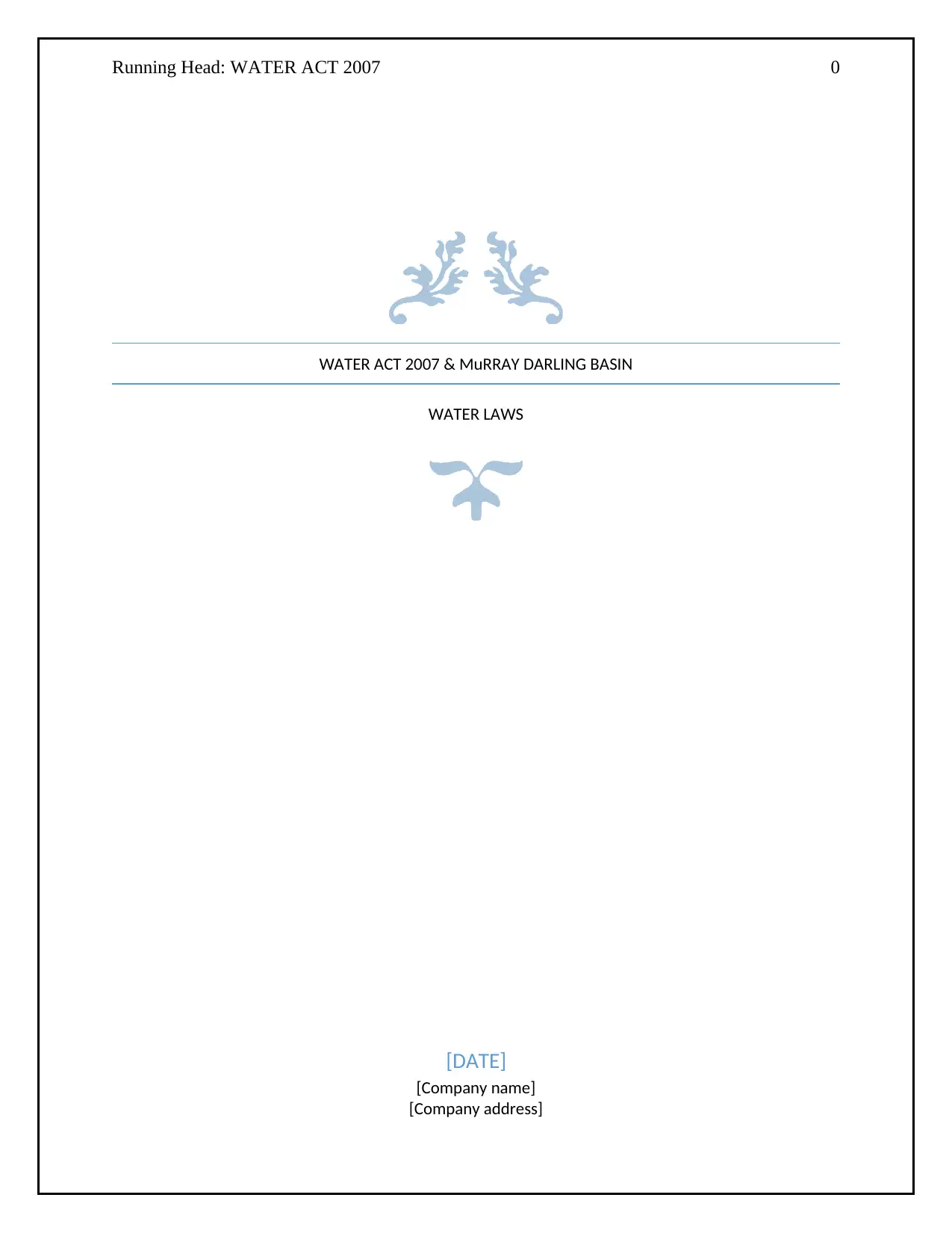
Running Head: WATER ACT 2007 0
WATER ACT 2007 & MuRRAY DARLING BASIN
WATER LAWS
[DATE]
[Company name]
[Company address]
WATER ACT 2007 & MuRRAY DARLING BASIN
WATER LAWS
[DATE]
[Company name]
[Company address]
Paraphrase This Document
Need a fresh take? Get an instant paraphrase of this document with our AI Paraphraser
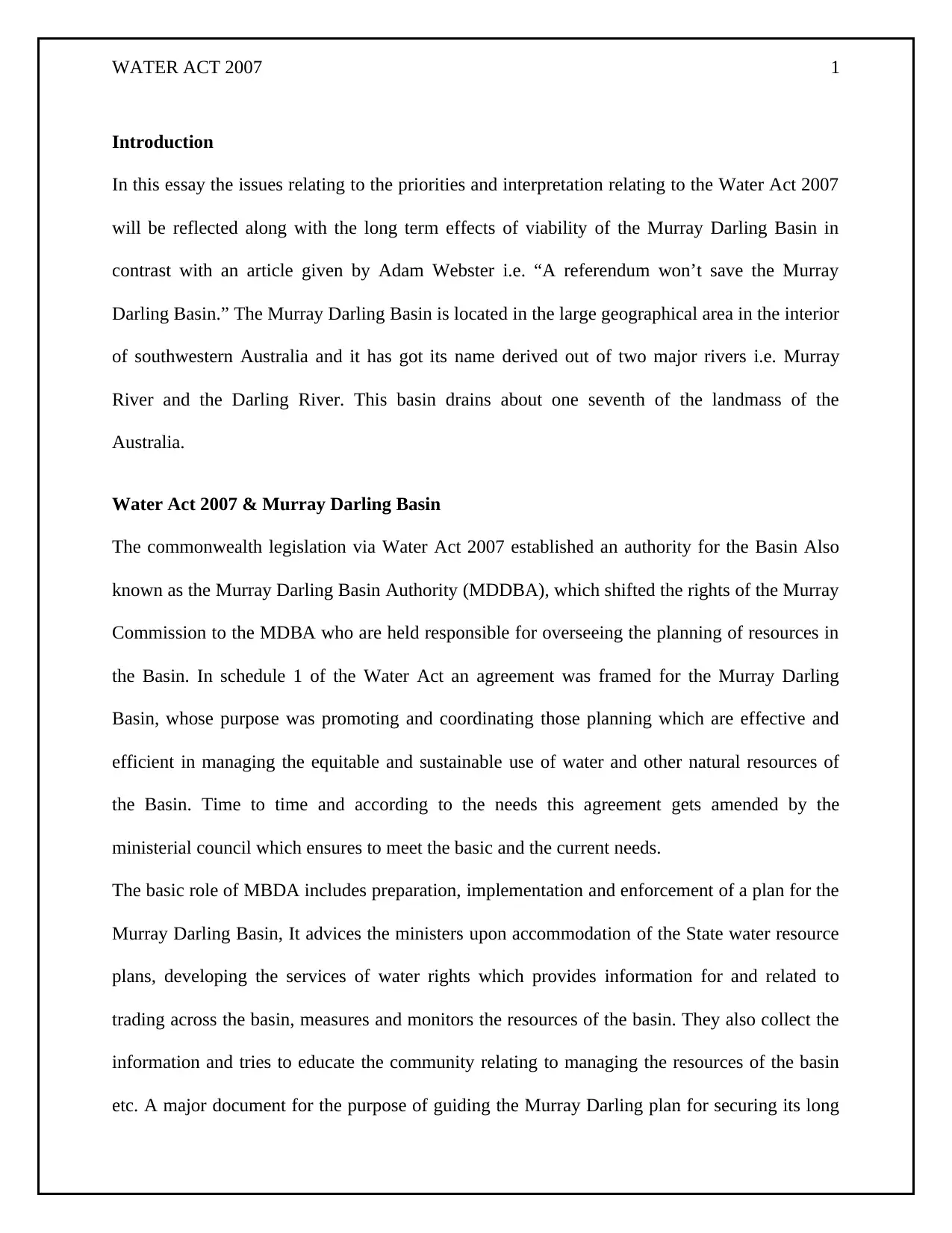
WATER ACT 2007 1
Introduction
In this essay the issues relating to the priorities and interpretation relating to the Water Act 2007
will be reflected along with the long term effects of viability of the Murray Darling Basin in
contrast with an article given by Adam Webster i.e. “A referendum won’t save the Murray
Darling Basin.” The Murray Darling Basin is located in the large geographical area in the interior
of southwestern Australia and it has got its name derived out of two major rivers i.e. Murray
River and the Darling River. This basin drains about one seventh of the landmass of the
Australia.
Water Act 2007 & Murray Darling Basin
The commonwealth legislation via Water Act 2007 established an authority for the Basin Also
known as the Murray Darling Basin Authority (MDDBA), which shifted the rights of the Murray
Commission to the MDBA who are held responsible for overseeing the planning of resources in
the Basin. In schedule 1 of the Water Act an agreement was framed for the Murray Darling
Basin, whose purpose was promoting and coordinating those planning which are effective and
efficient in managing the equitable and sustainable use of water and other natural resources of
the Basin. Time to time and according to the needs this agreement gets amended by the
ministerial council which ensures to meet the basic and the current needs.
The basic role of MBDA includes preparation, implementation and enforcement of a plan for the
Murray Darling Basin, It advices the ministers upon accommodation of the State water resource
plans, developing the services of water rights which provides information for and related to
trading across the basin, measures and monitors the resources of the basin. They also collect the
information and tries to educate the community relating to managing the resources of the basin
etc. A major document for the purpose of guiding the Murray Darling plan for securing its long
Introduction
In this essay the issues relating to the priorities and interpretation relating to the Water Act 2007
will be reflected along with the long term effects of viability of the Murray Darling Basin in
contrast with an article given by Adam Webster i.e. “A referendum won’t save the Murray
Darling Basin.” The Murray Darling Basin is located in the large geographical area in the interior
of southwestern Australia and it has got its name derived out of two major rivers i.e. Murray
River and the Darling River. This basin drains about one seventh of the landmass of the
Australia.
Water Act 2007 & Murray Darling Basin
The commonwealth legislation via Water Act 2007 established an authority for the Basin Also
known as the Murray Darling Basin Authority (MDDBA), which shifted the rights of the Murray
Commission to the MDBA who are held responsible for overseeing the planning of resources in
the Basin. In schedule 1 of the Water Act an agreement was framed for the Murray Darling
Basin, whose purpose was promoting and coordinating those planning which are effective and
efficient in managing the equitable and sustainable use of water and other natural resources of
the Basin. Time to time and according to the needs this agreement gets amended by the
ministerial council which ensures to meet the basic and the current needs.
The basic role of MBDA includes preparation, implementation and enforcement of a plan for the
Murray Darling Basin, It advices the ministers upon accommodation of the State water resource
plans, developing the services of water rights which provides information for and related to
trading across the basin, measures and monitors the resources of the basin. They also collect the
information and tries to educate the community relating to managing the resources of the basin
etc. A major document for the purpose of guiding the Murray Darling plan for securing its long
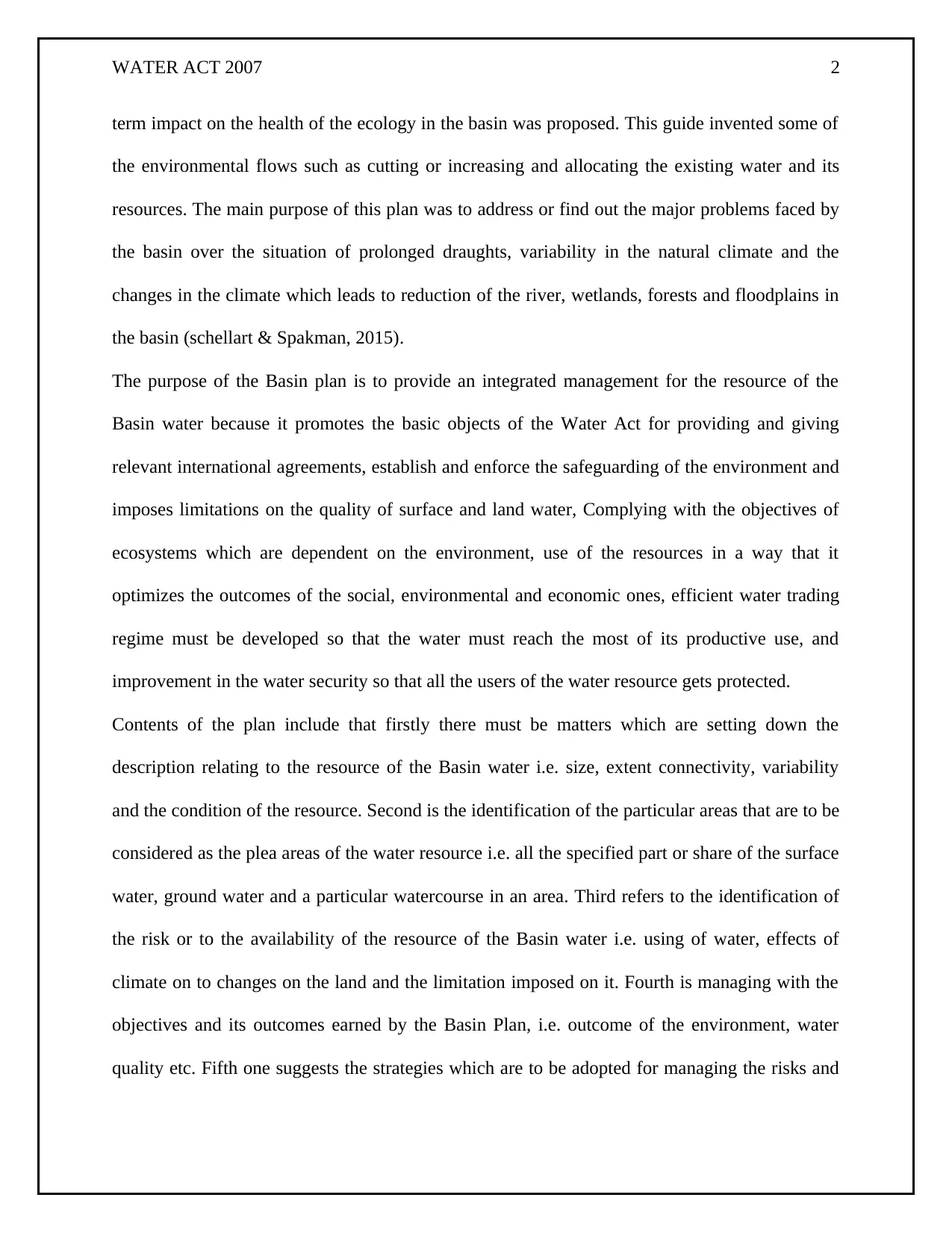
WATER ACT 2007 2
term impact on the health of the ecology in the basin was proposed. This guide invented some of
the environmental flows such as cutting or increasing and allocating the existing water and its
resources. The main purpose of this plan was to address or find out the major problems faced by
the basin over the situation of prolonged draughts, variability in the natural climate and the
changes in the climate which leads to reduction of the river, wetlands, forests and floodplains in
the basin (schellart & Spakman, 2015).
The purpose of the Basin plan is to provide an integrated management for the resource of the
Basin water because it promotes the basic objects of the Water Act for providing and giving
relevant international agreements, establish and enforce the safeguarding of the environment and
imposes limitations on the quality of surface and land water, Complying with the objectives of
ecosystems which are dependent on the environment, use of the resources in a way that it
optimizes the outcomes of the social, environmental and economic ones, efficient water trading
regime must be developed so that the water must reach the most of its productive use, and
improvement in the water security so that all the users of the water resource gets protected.
Contents of the plan include that firstly there must be matters which are setting down the
description relating to the resource of the Basin water i.e. size, extent connectivity, variability
and the condition of the resource. Second is the identification of the particular areas that are to be
considered as the plea areas of the water resource i.e. all the specified part or share of the surface
water, ground water and a particular watercourse in an area. Third refers to the identification of
the risk or to the availability of the resource of the Basin water i.e. using of water, effects of
climate on to changes on the land and the limitation imposed on it. Fourth is managing with the
objectives and its outcomes earned by the Basin Plan, i.e. outcome of the environment, water
quality etc. Fifth one suggests the strategies which are to be adopted for managing the risks and
term impact on the health of the ecology in the basin was proposed. This guide invented some of
the environmental flows such as cutting or increasing and allocating the existing water and its
resources. The main purpose of this plan was to address or find out the major problems faced by
the basin over the situation of prolonged draughts, variability in the natural climate and the
changes in the climate which leads to reduction of the river, wetlands, forests and floodplains in
the basin (schellart & Spakman, 2015).
The purpose of the Basin plan is to provide an integrated management for the resource of the
Basin water because it promotes the basic objects of the Water Act for providing and giving
relevant international agreements, establish and enforce the safeguarding of the environment and
imposes limitations on the quality of surface and land water, Complying with the objectives of
ecosystems which are dependent on the environment, use of the resources in a way that it
optimizes the outcomes of the social, environmental and economic ones, efficient water trading
regime must be developed so that the water must reach the most of its productive use, and
improvement in the water security so that all the users of the water resource gets protected.
Contents of the plan include that firstly there must be matters which are setting down the
description relating to the resource of the Basin water i.e. size, extent connectivity, variability
and the condition of the resource. Second is the identification of the particular areas that are to be
considered as the plea areas of the water resource i.e. all the specified part or share of the surface
water, ground water and a particular watercourse in an area. Third refers to the identification of
the risk or to the availability of the resource of the Basin water i.e. using of water, effects of
climate on to changes on the land and the limitation imposed on it. Fourth is managing with the
objectives and its outcomes earned by the Basin Plan, i.e. outcome of the environment, water
quality etc. Fifth one suggests the strategies which are to be adopted for managing the risks and
⊘ This is a preview!⊘
Do you want full access?
Subscribe today to unlock all pages.

Trusted by 1+ million students worldwide
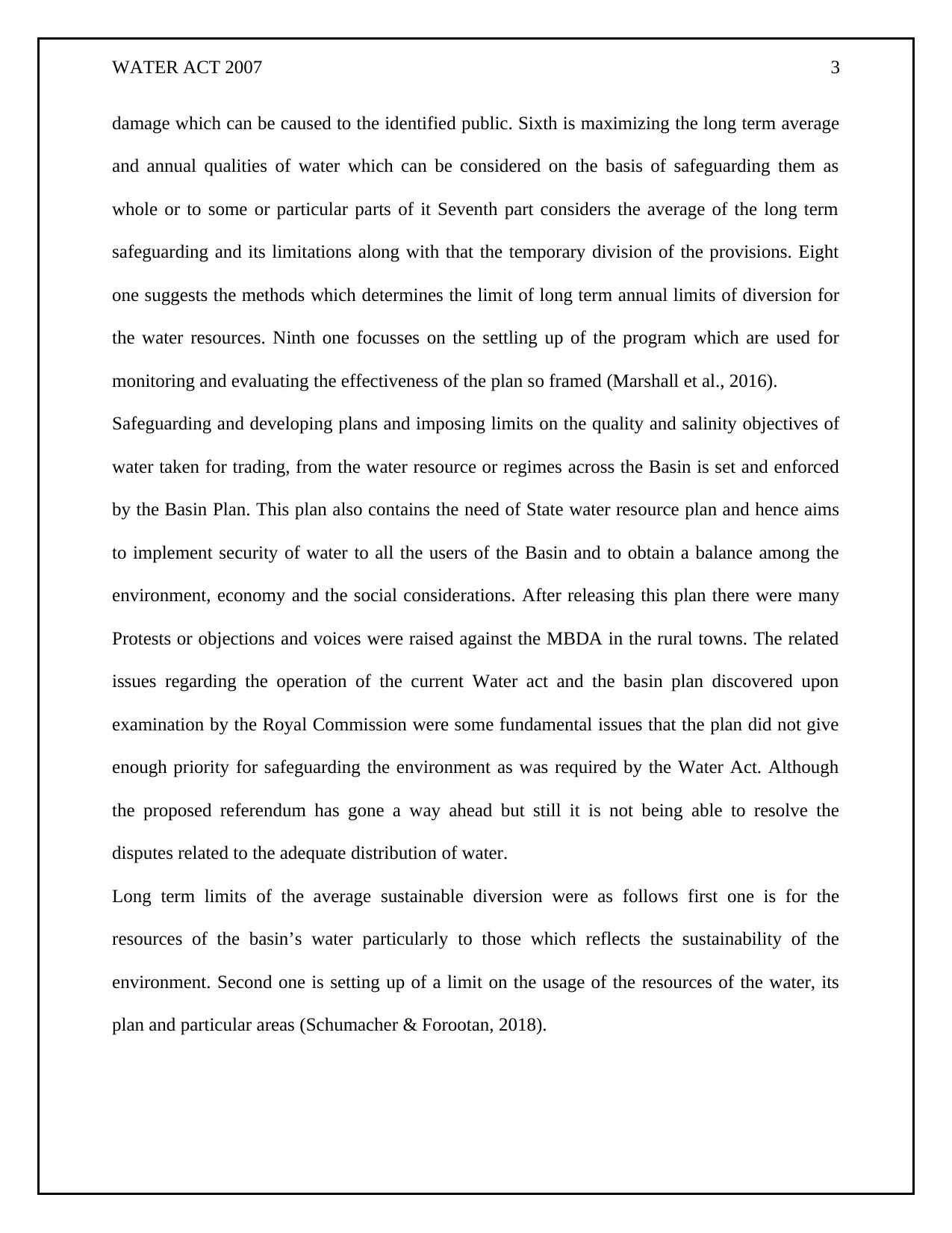
WATER ACT 2007 3
damage which can be caused to the identified public. Sixth is maximizing the long term average
and annual qualities of water which can be considered on the basis of safeguarding them as
whole or to some or particular parts of it Seventh part considers the average of the long term
safeguarding and its limitations along with that the temporary division of the provisions. Eight
one suggests the methods which determines the limit of long term annual limits of diversion for
the water resources. Ninth one focusses on the settling up of the program which are used for
monitoring and evaluating the effectiveness of the plan so framed (Marshall et al., 2016).
Safeguarding and developing plans and imposing limits on the quality and salinity objectives of
water taken for trading, from the water resource or regimes across the Basin is set and enforced
by the Basin Plan. This plan also contains the need of State water resource plan and hence aims
to implement security of water to all the users of the Basin and to obtain a balance among the
environment, economy and the social considerations. After releasing this plan there were many
Protests or objections and voices were raised against the MBDA in the rural towns. The related
issues regarding the operation of the current Water act and the basin plan discovered upon
examination by the Royal Commission were some fundamental issues that the plan did not give
enough priority for safeguarding the environment as was required by the Water Act. Although
the proposed referendum has gone a way ahead but still it is not being able to resolve the
disputes related to the adequate distribution of water.
Long term limits of the average sustainable diversion were as follows first one is for the
resources of the basin’s water particularly to those which reflects the sustainability of the
environment. Second one is setting up of a limit on the usage of the resources of the water, its
plan and particular areas (Schumacher & Forootan, 2018).
damage which can be caused to the identified public. Sixth is maximizing the long term average
and annual qualities of water which can be considered on the basis of safeguarding them as
whole or to some or particular parts of it Seventh part considers the average of the long term
safeguarding and its limitations along with that the temporary division of the provisions. Eight
one suggests the methods which determines the limit of long term annual limits of diversion for
the water resources. Ninth one focusses on the settling up of the program which are used for
monitoring and evaluating the effectiveness of the plan so framed (Marshall et al., 2016).
Safeguarding and developing plans and imposing limits on the quality and salinity objectives of
water taken for trading, from the water resource or regimes across the Basin is set and enforced
by the Basin Plan. This plan also contains the need of State water resource plan and hence aims
to implement security of water to all the users of the Basin and to obtain a balance among the
environment, economy and the social considerations. After releasing this plan there were many
Protests or objections and voices were raised against the MBDA in the rural towns. The related
issues regarding the operation of the current Water act and the basin plan discovered upon
examination by the Royal Commission were some fundamental issues that the plan did not give
enough priority for safeguarding the environment as was required by the Water Act. Although
the proposed referendum has gone a way ahead but still it is not being able to resolve the
disputes related to the adequate distribution of water.
Long term limits of the average sustainable diversion were as follows first one is for the
resources of the basin’s water particularly to those which reflects the sustainability of the
environment. Second one is setting up of a limit on the usage of the resources of the water, its
plan and particular areas (Schumacher & Forootan, 2018).
Paraphrase This Document
Need a fresh take? Get an instant paraphrase of this document with our AI Paraphraser

WATER ACT 2007 4
Links and impacts of Murray Darling Basin on the environment, social issues and the law are as
follows, firstly its impact on the socio environment reflects that there must be appropriate
knowledge of water for managing the water resources, understanding its ecological response and
the flow of regulation is very essential for aiding the management process of the environment.
The Basin plan has aimed to recover the water so that the health of the environment can be
improved and deliver more of natural and variable flows in the environmental flow forms. The
concerns of the environment like change in the climate, deforestation, scarcity of water, going
down bio diversities and soil erosion are the problems faced globally, US for this stated that it is
the responsibility of one and all to promote harmony with the nature and the earth so to achieve a
required balance in the social, economic and the environmental needs of the present as well as
the future generation of the humanity, which is not an easy thing to do, Adequate knowledge of
the concerns dealing with the environment such as living conditions and the poverty rate, level of
hunger etc. must be provided to all the citizens by their nations (Swirepik et al., 2016).
Works done for protecting the environment includes one promoting of the sustainable farming
practices i.e. creation of such communities and firms where the people learn to get composited
with the methods like drip irrigation which improves the crops, restoring of soil and its fertility
and to make the best use of resources which are getting scare. Second one is increase in the
access for maintaining sustainable agricultural technologies i.e. giving training and credit to the
people so that they may adopt new and upcoming agricultural technologies and the practices and
also to encourage the people to extend the services in the field of agriculture. Third states that the
awareness of building capacity and capacity to adopt to the climate change must be raised. Lastly
more and more reforestation and tree planting campaign must are to be facilitated (Hart, 2016).
Links and impacts of Murray Darling Basin on the environment, social issues and the law are as
follows, firstly its impact on the socio environment reflects that there must be appropriate
knowledge of water for managing the water resources, understanding its ecological response and
the flow of regulation is very essential for aiding the management process of the environment.
The Basin plan has aimed to recover the water so that the health of the environment can be
improved and deliver more of natural and variable flows in the environmental flow forms. The
concerns of the environment like change in the climate, deforestation, scarcity of water, going
down bio diversities and soil erosion are the problems faced globally, US for this stated that it is
the responsibility of one and all to promote harmony with the nature and the earth so to achieve a
required balance in the social, economic and the environmental needs of the present as well as
the future generation of the humanity, which is not an easy thing to do, Adequate knowledge of
the concerns dealing with the environment such as living conditions and the poverty rate, level of
hunger etc. must be provided to all the citizens by their nations (Swirepik et al., 2016).
Works done for protecting the environment includes one promoting of the sustainable farming
practices i.e. creation of such communities and firms where the people learn to get composited
with the methods like drip irrigation which improves the crops, restoring of soil and its fertility
and to make the best use of resources which are getting scare. Second one is increase in the
access for maintaining sustainable agricultural technologies i.e. giving training and credit to the
people so that they may adopt new and upcoming agricultural technologies and the practices and
also to encourage the people to extend the services in the field of agriculture. Third states that the
awareness of building capacity and capacity to adopt to the climate change must be raised. Lastly
more and more reforestation and tree planting campaign must are to be facilitated (Hart, 2016).
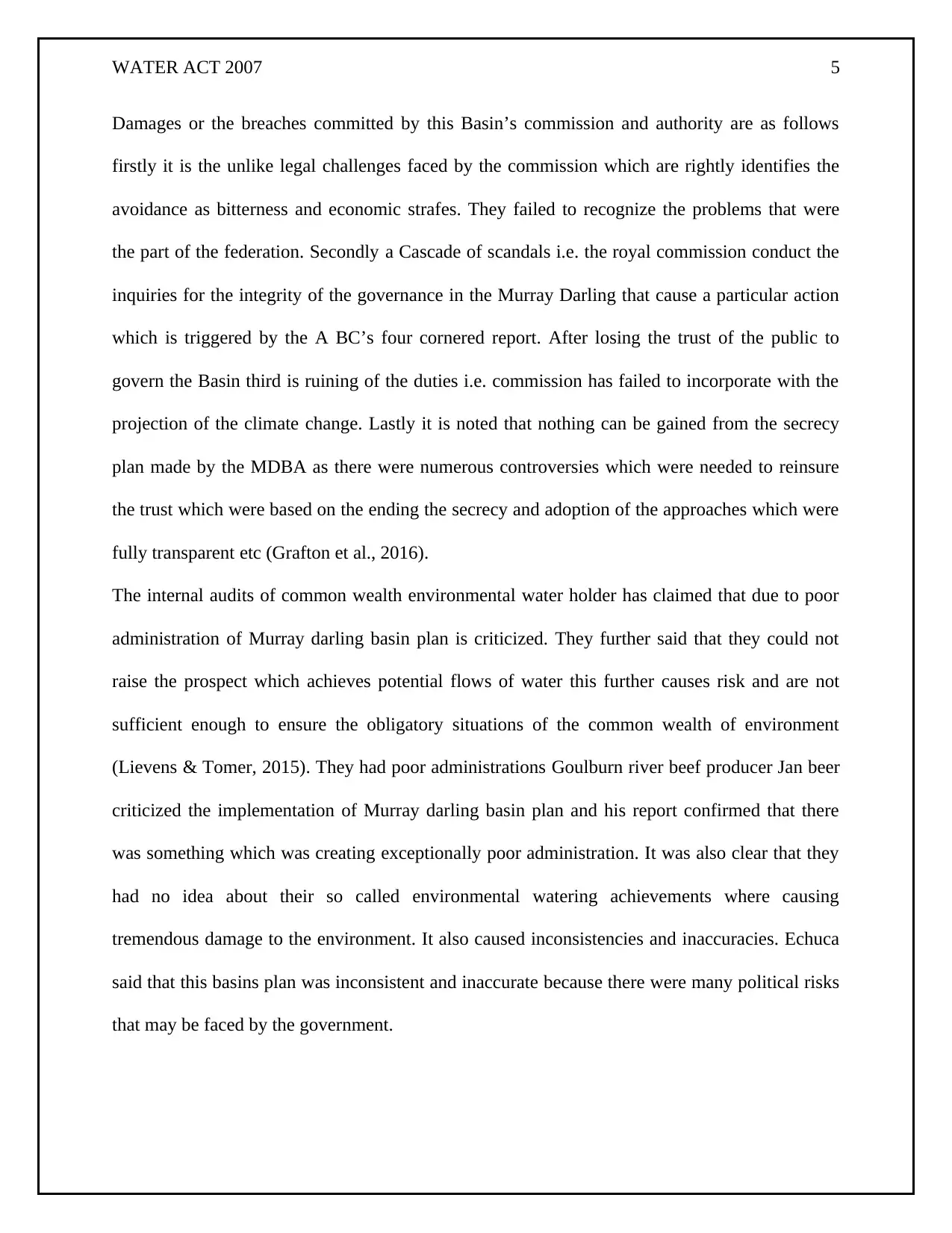
WATER ACT 2007 5
Damages or the breaches committed by this Basin’s commission and authority are as follows
firstly it is the unlike legal challenges faced by the commission which are rightly identifies the
avoidance as bitterness and economic strafes. They failed to recognize the problems that were
the part of the federation. Secondly a Cascade of scandals i.e. the royal commission conduct the
inquiries for the integrity of the governance in the Murray Darling that cause a particular action
which is triggered by the A BC’s four cornered report. After losing the trust of the public to
govern the Basin third is ruining of the duties i.e. commission has failed to incorporate with the
projection of the climate change. Lastly it is noted that nothing can be gained from the secrecy
plan made by the MDBA as there were numerous controversies which were needed to reinsure
the trust which were based on the ending the secrecy and adoption of the approaches which were
fully transparent etc (Grafton et al., 2016).
The internal audits of common wealth environmental water holder has claimed that due to poor
administration of Murray darling basin plan is criticized. They further said that they could not
raise the prospect which achieves potential flows of water this further causes risk and are not
sufficient enough to ensure the obligatory situations of the common wealth of environment
(Lievens & Tomer, 2015). They had poor administrations Goulburn river beef producer Jan beer
criticized the implementation of Murray darling basin plan and his report confirmed that there
was something which was creating exceptionally poor administration. It was also clear that they
had no idea about their so called environmental watering achievements where causing
tremendous damage to the environment. It also caused inconsistencies and inaccuracies. Echuca
said that this basins plan was inconsistent and inaccurate because there were many political risks
that may be faced by the government.
Damages or the breaches committed by this Basin’s commission and authority are as follows
firstly it is the unlike legal challenges faced by the commission which are rightly identifies the
avoidance as bitterness and economic strafes. They failed to recognize the problems that were
the part of the federation. Secondly a Cascade of scandals i.e. the royal commission conduct the
inquiries for the integrity of the governance in the Murray Darling that cause a particular action
which is triggered by the A BC’s four cornered report. After losing the trust of the public to
govern the Basin third is ruining of the duties i.e. commission has failed to incorporate with the
projection of the climate change. Lastly it is noted that nothing can be gained from the secrecy
plan made by the MDBA as there were numerous controversies which were needed to reinsure
the trust which were based on the ending the secrecy and adoption of the approaches which were
fully transparent etc (Grafton et al., 2016).
The internal audits of common wealth environmental water holder has claimed that due to poor
administration of Murray darling basin plan is criticized. They further said that they could not
raise the prospect which achieves potential flows of water this further causes risk and are not
sufficient enough to ensure the obligatory situations of the common wealth of environment
(Lievens & Tomer, 2015). They had poor administrations Goulburn river beef producer Jan beer
criticized the implementation of Murray darling basin plan and his report confirmed that there
was something which was creating exceptionally poor administration. It was also clear that they
had no idea about their so called environmental watering achievements where causing
tremendous damage to the environment. It also caused inconsistencies and inaccuracies. Echuca
said that this basins plan was inconsistent and inaccurate because there were many political risks
that may be faced by the government.
⊘ This is a preview!⊘
Do you want full access?
Subscribe today to unlock all pages.

Trusted by 1+ million students worldwide
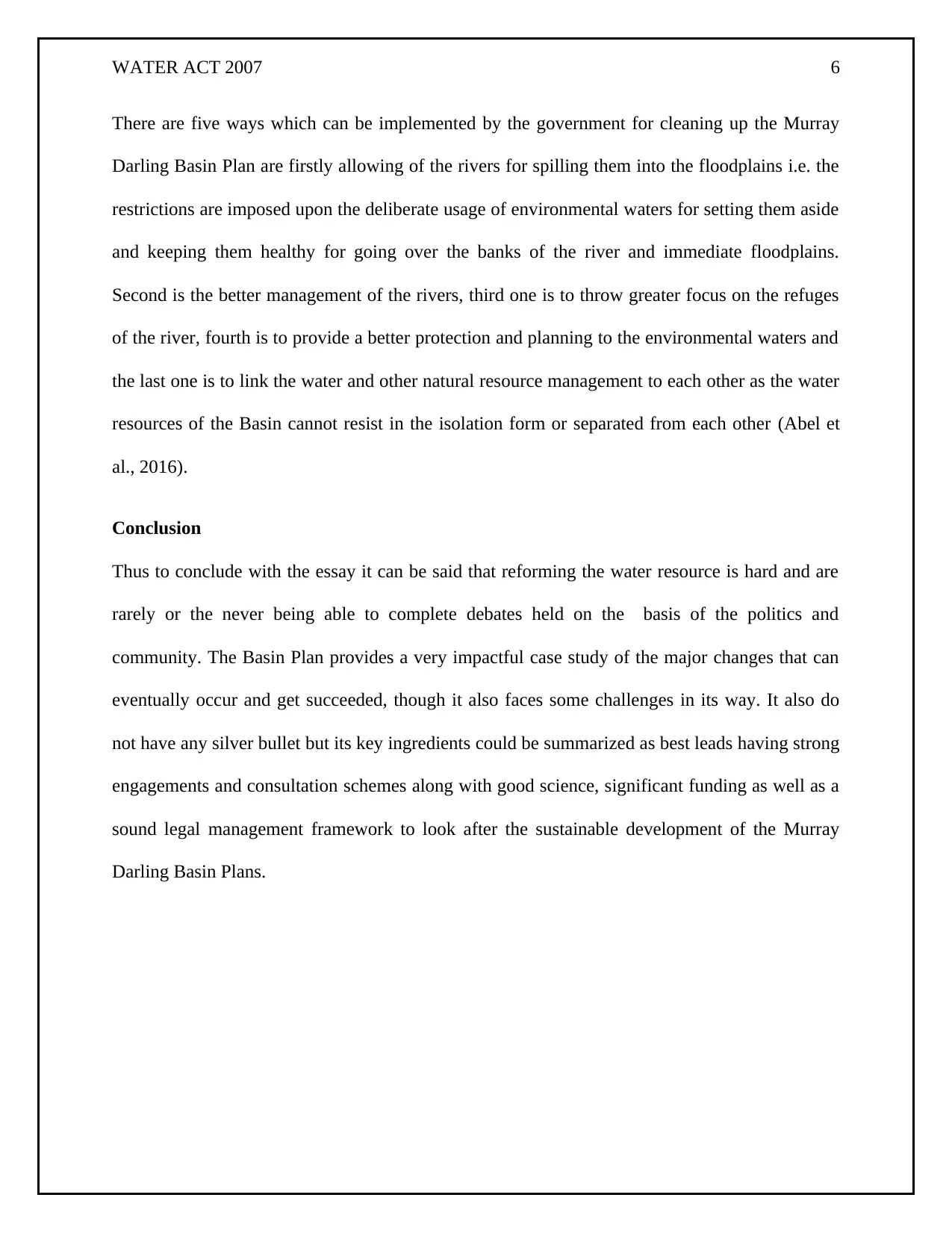
WATER ACT 2007 6
There are five ways which can be implemented by the government for cleaning up the Murray
Darling Basin Plan are firstly allowing of the rivers for spilling them into the floodplains i.e. the
restrictions are imposed upon the deliberate usage of environmental waters for setting them aside
and keeping them healthy for going over the banks of the river and immediate floodplains.
Second is the better management of the rivers, third one is to throw greater focus on the refuges
of the river, fourth is to provide a better protection and planning to the environmental waters and
the last one is to link the water and other natural resource management to each other as the water
resources of the Basin cannot resist in the isolation form or separated from each other (Abel et
al., 2016).
Conclusion
Thus to conclude with the essay it can be said that reforming the water resource is hard and are
rarely or the never being able to complete debates held on the basis of the politics and
community. The Basin Plan provides a very impactful case study of the major changes that can
eventually occur and get succeeded, though it also faces some challenges in its way. It also do
not have any silver bullet but its key ingredients could be summarized as best leads having strong
engagements and consultation schemes along with good science, significant funding as well as a
sound legal management framework to look after the sustainable development of the Murray
Darling Basin Plans.
There are five ways which can be implemented by the government for cleaning up the Murray
Darling Basin Plan are firstly allowing of the rivers for spilling them into the floodplains i.e. the
restrictions are imposed upon the deliberate usage of environmental waters for setting them aside
and keeping them healthy for going over the banks of the river and immediate floodplains.
Second is the better management of the rivers, third one is to throw greater focus on the refuges
of the river, fourth is to provide a better protection and planning to the environmental waters and
the last one is to link the water and other natural resource management to each other as the water
resources of the Basin cannot resist in the isolation form or separated from each other (Abel et
al., 2016).
Conclusion
Thus to conclude with the essay it can be said that reforming the water resource is hard and are
rarely or the never being able to complete debates held on the basis of the politics and
community. The Basin Plan provides a very impactful case study of the major changes that can
eventually occur and get succeeded, though it also faces some challenges in its way. It also do
not have any silver bullet but its key ingredients could be summarized as best leads having strong
engagements and consultation schemes along with good science, significant funding as well as a
sound legal management framework to look after the sustainable development of the Murray
Darling Basin Plans.
Paraphrase This Document
Need a fresh take? Get an instant paraphrase of this document with our AI Paraphraser
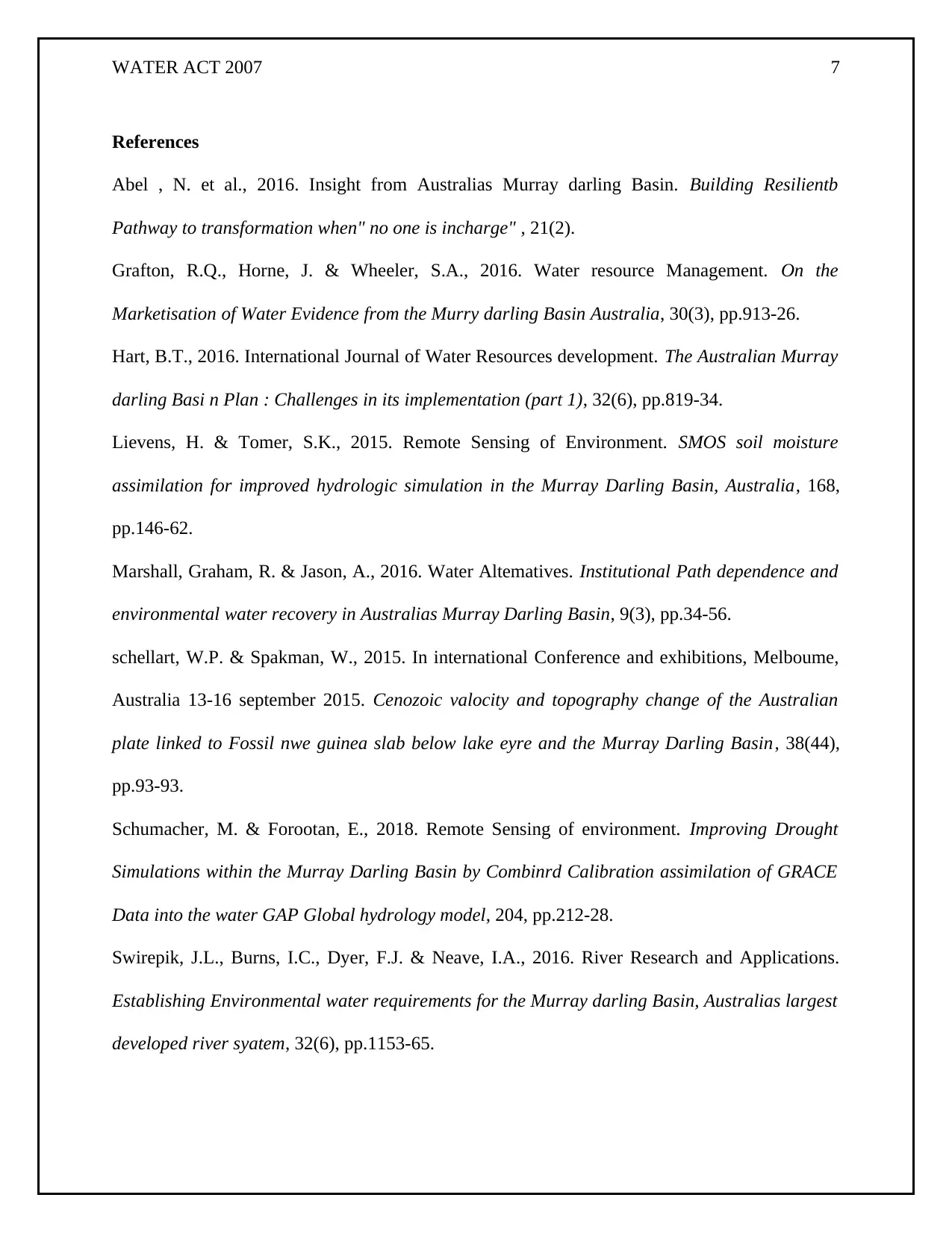
WATER ACT 2007 7
References
Abel , N. et al., 2016. Insight from Australias Murray darling Basin. Building Resilientb
Pathway to transformation when" no one is incharge" , 21(2).
Grafton, R.Q., Horne, J. & Wheeler, S.A., 2016. Water resource Management. On the
Marketisation of Water Evidence from the Murry darling Basin Australia, 30(3), pp.913-26.
Hart, B.T., 2016. International Journal of Water Resources development. The Australian Murray
darling Basi n Plan : Challenges in its implementation (part 1), 32(6), pp.819-34.
Lievens, H. & Tomer, S.K., 2015. Remote Sensing of Environment. SMOS soil moisture
assimilation for improved hydrologic simulation in the Murray Darling Basin, Australia, 168,
pp.146-62.
Marshall, Graham, R. & Jason, A., 2016. Water Altematives. Institutional Path dependence and
environmental water recovery in Australias Murray Darling Basin, 9(3), pp.34-56.
schellart, W.P. & Spakman, W., 2015. In international Conference and exhibitions, Melboume,
Australia 13-16 september 2015. Cenozoic valocity and topography change of the Australian
plate linked to Fossil nwe guinea slab below lake eyre and the Murray Darling Basin, 38(44),
pp.93-93.
Schumacher, M. & Forootan, E., 2018. Remote Sensing of environment. Improving Drought
Simulations within the Murray Darling Basin by Combinrd Calibration assimilation of GRACE
Data into the water GAP Global hydrology model, 204, pp.212-28.
Swirepik, J.L., Burns, I.C., Dyer, F.J. & Neave, I.A., 2016. River Research and Applications.
Establishing Environmental water requirements for the Murray darling Basin, Australias largest
developed river syatem, 32(6), pp.1153-65.
References
Abel , N. et al., 2016. Insight from Australias Murray darling Basin. Building Resilientb
Pathway to transformation when" no one is incharge" , 21(2).
Grafton, R.Q., Horne, J. & Wheeler, S.A., 2016. Water resource Management. On the
Marketisation of Water Evidence from the Murry darling Basin Australia, 30(3), pp.913-26.
Hart, B.T., 2016. International Journal of Water Resources development. The Australian Murray
darling Basi n Plan : Challenges in its implementation (part 1), 32(6), pp.819-34.
Lievens, H. & Tomer, S.K., 2015. Remote Sensing of Environment. SMOS soil moisture
assimilation for improved hydrologic simulation in the Murray Darling Basin, Australia, 168,
pp.146-62.
Marshall, Graham, R. & Jason, A., 2016. Water Altematives. Institutional Path dependence and
environmental water recovery in Australias Murray Darling Basin, 9(3), pp.34-56.
schellart, W.P. & Spakman, W., 2015. In international Conference and exhibitions, Melboume,
Australia 13-16 september 2015. Cenozoic valocity and topography change of the Australian
plate linked to Fossil nwe guinea slab below lake eyre and the Murray Darling Basin, 38(44),
pp.93-93.
Schumacher, M. & Forootan, E., 2018. Remote Sensing of environment. Improving Drought
Simulations within the Murray Darling Basin by Combinrd Calibration assimilation of GRACE
Data into the water GAP Global hydrology model, 204, pp.212-28.
Swirepik, J.L., Burns, I.C., Dyer, F.J. & Neave, I.A., 2016. River Research and Applications.
Establishing Environmental water requirements for the Murray darling Basin, Australias largest
developed river syatem, 32(6), pp.1153-65.
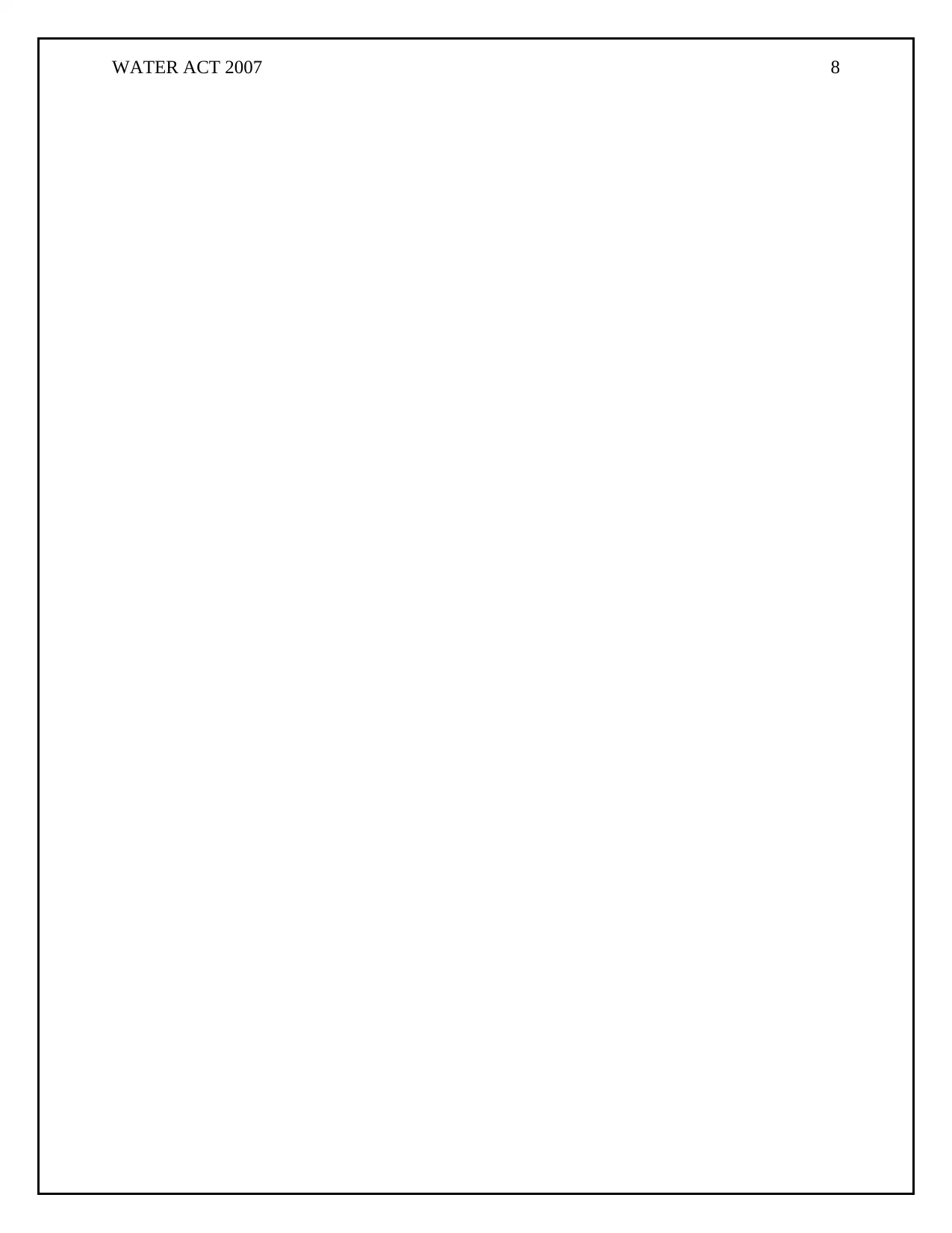
WATER ACT 2007 8
⊘ This is a preview!⊘
Do you want full access?
Subscribe today to unlock all pages.

Trusted by 1+ million students worldwide
1 out of 9
Related Documents
Your All-in-One AI-Powered Toolkit for Academic Success.
+13062052269
info@desklib.com
Available 24*7 on WhatsApp / Email
![[object Object]](/_next/static/media/star-bottom.7253800d.svg)
Unlock your academic potential
© 2024 | Zucol Services PVT LTD | All rights reserved.




